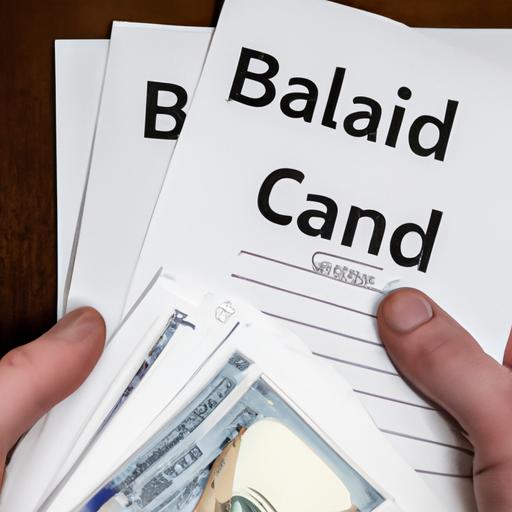Are you drowning in credit card debt, struggling to keep up with multiple payments and high interest rates? If so, it’s time to take control of your financial situation by consolidating your credit card debt. In this article, we will explore the ins and outs of credit card debt consolidation, why it is crucial, and the numerous benefits it offers.
A. Definition of Credit Card Debt Consolidation
Credit card debt consolidation refers to the process of combining multiple credit card debts into a single loan or credit facility. By consolidating your debts, you can simplify your monthly payment obligations and potentially secure a lower interest rate. This financial strategy enables you to manage your debt more efficiently and ultimately pay off your credit card balances faster.
B. Importance of Consolidating Credit Card Debt
Why is consolidating credit card debt so important? Well, imagine juggling multiple credit card bills each month, each with its own due date and interest rate. It can quickly become overwhelming and lead to missed payments, late fees, and a never-ending cycle of debt. Consolidating your credit card debt streamlines this process, making it easier to stay on top of your obligations and regain control of your finances.
C. Benefits of Consolidating Credit Card Debt
Consolidating your credit card debt offers a plethora of benefits that can positively impact your financial well-being. Firstly, it simplifies your monthly payments, as you only need to worry about a single payment instead of multiple ones. This reduces the chances of missing payments and incurring additional fees or penalties.
Secondly, consolidating your credit card debt can potentially lower your interest rate. If you qualify for a consolidation option with a lower interest rate than your current credit cards, you can save a significant amount of money over time. This means more of your payment goes towards reducing your principal balance, allowing you to pay off your debt faster.
Lastly, credit card debt consolidation can improve your credit score. As you make regular payments towards your consolidated debt, your credit utilization ratio decreases, which positively impacts your creditworthiness. A higher credit score opens doors to better loan terms and lower interest rates in the future.
In the upcoming sections, we will delve deeper into the various consolidation options available and the step-by-step process to consolidate your credit card debt. By the end of this article, you’ll have the knowledge and confidence to take charge of your financial situation and embark on the journey towards a debt-free life. So, let’s get started!
Understanding Credit Card Debt
A. Definition of Credit Card Debt
Credit card debt refers to the outstanding balance that individuals owe to credit card companies for purchases made using their credit cards. When you make a purchase with a credit card, you are essentially borrowing money from the card issuer. Failure to pay off the borrowed amount by the due date results in a balance carried over to the next billing cycle, accumulating interest charges.
B. Common Reasons for Accumulating Credit Card Debt
Why do people find themselves buried in credit card debt? It can be attributed to various factors, such as:
-
Impulse Spending: The ease and convenience of credit cards can lead to impulsive purchases. Without proper financial discipline, it’s easy to rack up debt by spending beyond one’s means.
-
Emergency Expenses: Unforeseen circumstances, such as medical emergencies or car repairs, can force individuals to rely on credit cards to cover the costs when they lack sufficient savings.
-
Lack of Budgeting: Failing to create and stick to a budget can result in overspending and relying on credit cards to make ends meet.
-
High Cost of Living: Living in areas with a high cost of living can make it challenging to meet expenses, leading individuals to rely on credit cards to bridge the gap.
C. Negative Impacts of Credit Card Debt
Carrying a substantial amount of credit card debt can have detrimental effects on your financial well-being. Some negative impacts include:
-
High Interest Charges: Credit cards often come with high interest rates, meaning that if you only make minimum payments, a significant portion of your payment goes towards interest, prolonging your debt repayment journey.
-
Negative Credit Score: Accumulating too much credit card debt can harm your credit score. High credit utilization, missed payments, and carrying high balances can all negatively impact your creditworthiness, making it harder to secure favorable loan terms in the future.
-
Financial Stress: Being burdened by credit card debt can cause significant stress and anxiety. The constant worry about making payments and the feeling of being trapped in a debt cycle can take a toll on your mental well-being.
Understanding the nature of credit card debt, the reasons behind its accumulation, and the negative consequences it can have is crucial in realizing the importance of consolidating this debt. In the following sections, we will explore various consolidation options available to help you regain control of your finances and pave the way towards a debt-free future.
Consolidation Options for Credit Card Debt
When it comes to consolidating your credit card debt, you have several options to choose from. Each option has its own advantages and considerations, so let’s explore them in detail.
A. Balance Transfer Credit Cards
One popular option for consolidating credit card debt is utilizing balance transfer credit cards. These cards allow you to transfer your existing credit card balances onto a new card with a lower or 0% introductory interest rate. This can provide temporary relief from high interest payments and give you a chance to pay off your debts more effectively.
1. Explanation of Balance Transfer Process
To initiate a balance transfer, you’ll need to apply for a balance transfer credit card and provide the necessary information, including the amount you wish to transfer. Once approved, the new card issuer will pay off your existing credit card balances, consolidating them onto the new card. This leaves you with a single payment to make each month.
2. Pros and Cons of Using Balance Transfer Credit Cards
Balance transfer credit cards offer several advantages. They often come with a promotional period of 0% interest for a set duration, allowing you to make significant progress in paying off your debt without accruing additional interest. Additionally, consolidating multiple balances onto one card simplifies your finances and may help you avoid late payments.
However, it’s important to consider the potential downsides. Balance transfer fees may apply, typically a percentage of the total amount transferred. Additionally, if you don’t pay off the entire balance before the promotional period ends, the interest rate may increase significantly, leaving you in a worse financial position.
B. Personal Loans
Another consolidation option is obtaining a personal loan to pay off your credit card debt. Personal loans are unsecured loans that you can use for various purposes, including debt consolidation.
1. How Personal Loans Can Help Consolidate Credit Card Debt
Personal loans allow you to borrow a lump sum of money, which you can use to pay off your credit card balances in full. By doing so, you’ll have a single loan payment to focus on, often at a lower interest rate compared to credit cards. This can save you money in interest charges and help you pay off your debt more efficiently.
2. Advantages and Disadvantages of Using Personal Loans
One advantage of personal loans is the fixed repayment period and predictable monthly payments. This allows you to budget more effectively and ensures that you’ll be debt-free by the end of the loan term. Personal loans also have lower interest rates than most credit cards, saving you money in the long run.
On the other hand, personal loans may require a good credit score for approval, and the interest rate offered will depend on your creditworthiness. Additionally, taking on a personal loan means taking on new debt, so it’s crucial to have a solid repayment plan in place to avoid falling into further financial trouble.
C. Home Equity Loans or Lines of Credit
If you own a home and have built up equity, you may consider using a home equity loan or line of credit to consolidate your credit card debt.
1. Overview of Home Equity Loans and Lines of Credit
A home equity loan allows you to borrow against the equity you’ve built in your home. It provides a lump sum of money that you can use to pay off your credit card debt. On the other hand, a home equity line of credit (HELOC) acts more like a credit card, allowing you to borrow as needed up to a certain limit.
2. Considerations When Using Home Equity to Consolidate Debt
Using your home equity to consolidate debt can offer advantages such as lower interest rates and potentially tax-deductible interest payments. However, it’s important to remember that you’re putting your home at risk. If you fail to make payments on a home equity loan or HELOC, you could potentially lose your house.
Before utilizing a home equity loan or line of credit, carefully consider your financial situation and consult with a professional to ensure it’s the right option for you.
In the next section, we’ll guide you through the step-by-step process of consolidating your credit card debt, empowering you to take control of your financial future. Stay tuned!
Steps to Consolidate Credit Card Debt
Are you ready to take the leap towards consolidating your credit card debt? This section will guide you through the essential steps to follow in order to successfully consolidate your debts and pave the way to financial freedom.
A. Assessing the Total Debt
The first step in consolidating your credit card debt is to assess the total amount you owe. Begin by calculating the combined balance of all your credit cards. Take into account not only the outstanding balances but also any accrued interest or fees. This comprehensive evaluation will give you a clear picture of your debt and serve as a starting point for your consolidation journey.
Next, gather all the necessary financial information related to your credit cards. This includes statements, interest rates, minimum payment requirements, and any other relevant documentation. Having these details readily available will streamline the consolidation process and help you make informed decisions moving forward.
B. Researching and Comparing Consolidation Options
With your total debt in mind, it’s time to research and compare the available consolidation options. Start by evaluating the interest rates and fees associated with each option. Look for options that offer lower interest rates than your current credit cards to ensure you save money in the long run.
Additionally, understanding the repayment terms and conditions of each consolidation option is crucial. Consider factors such as the length of the repayment period, monthly payment requirements, and any potential penalties or fees for early repayment. This analysis will help you choose the consolidation option that aligns best with your financial goals and capabilities.
C. Applying for the Chosen Consolidation Option
Once you have decided on a consolidation option that suits your needs, it’s time to proceed with the application process. Start by preparing all the required documents, such as proof of income, identification, and any other documentation specific to the chosen consolidation option. Gather these documents beforehand to expedite the application process.
Next, complete the application process according to the requirements of the chosen consolidation option. Ensure that you provide accurate and truthful information to increase your chances of approval. If necessary, seek guidance from financial professionals or advisors to navigate through the application process smoothly.
By following these steps diligently, you will be well on your way to consolidating your credit card debt. In the next section, we will explore the strategies and techniques for effectively managing your consolidated debt, allowing you to regain control of your financial future.
Managing Consolidated Credit Card Debt
Once you have consolidated your credit card debt, it’s important to have a plan in place to effectively manage and ultimately eliminate it. In this section, we will explore key strategies for managing your consolidated debt and ensuring a brighter financial future.
A. Developing a Budget and Repayment Plan
To successfully manage your consolidated credit card debt, the first step is to create a realistic budget. Take a close look at your income and expenses to determine how much you can allocate towards debt repayment each month. By setting a budget, you’ll have a clear understanding of your financial limitations and can make informed decisions about your spending habits.
Next, it’s crucial to allocate funds specifically for debt repayment. Prioritize making consistent and timely payments towards your consolidated debt to avoid falling back into the debt cycle. Consider automating your payments or setting up reminders to ensure you never miss a payment.
B. Utilizing Debt Management Strategies
Debt management strategies can significantly expedite your journey towards becoming debt-free. One effective method is prioritizing your debt payments. Start by focusing on the debt with the highest interest rate while still making minimum payments on the others. Once the highest-interest debt is paid off, redirect those funds towards the next highest-interest debt until all debts are cleared.
Another popular approach is the debt snowball or debt avalanche method. With the snowball method, you pay off your smallest debt first, then move on to the next smallest, creating momentum as you eliminate debts one by one. The avalanche method, on the other hand, targets debts with the highest interest rates first, allowing you to save more on interest over time.
C. Avoiding Future Credit Card Debt Accumulation
Consolidating your credit card debt is just the first step towards financial stability. To prevent future debt accumulation, it’s crucial to practice responsible credit card usage. Avoid unnecessary spending and only charge what you can afford to pay off in full each month. By using credit cards responsibly, you can avoid falling back into the cycle of debt and maintain a healthy financial status.
Additionally, consider establishing an emergency fund. Having a cushion of savings can help cover unexpected expenses or emergencies, reducing the need to rely on credit cards in times of financial strain. Aim to save three to six months’ worth of living expenses to provide a safety net and avoid resorting to credit cards as a last resort.
By following these strategies and maintaining a disciplined approach, you can successfully manage your consolidated credit card debt, improve your financial health, and pave the way for a debt-free future.
Stay tuned for the next section, where we will explore the importance of choosing the right consolidation option to suit your unique financial situation.
Conclusion
Consolidating credit card debt is the key to regaining control of your financial future. By taking the necessary steps to consolidate your debts, you can simplify your payments, reduce your interest rates, and ultimately pay off your debt faster.
Throughout this article, we have explored the definition of credit card debt consolidation and highlighted its importance. We have also discussed the numerous benefits that come with consolidating your credit card debt, including simplified payments, potential interest rate reductions, and improved credit scores.
Remember, taking action is the first step towards financial freedom. Assess your total debt, research and compare consolidation options, and apply for the option that suits your needs best. Once you have consolidated your credit card debt, it is crucial to manage it effectively. Develop a budget, prioritize debt payments, and avoid accumulating new credit card debt.
If you find yourself overwhelmed or unsure about the consolidation process, don’t hesitate to seek professional advice. Financial experts can provide guidance tailored to your specific situation and help you make informed decisions.
Consolidating credit card debt is not only about eliminating financial burdens; it’s about gaining control of your life. Imagine the relief of having a single payment to focus on, the satisfaction of watching your debt decrease, and the freedom that comes with being debt-free.
So, take that first step today. Consolidate your credit card debt and embark on a journey towards a brighter financial future. You deserve it!





